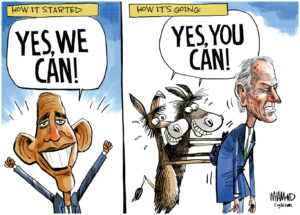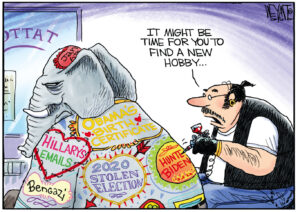The Global Economy Is a Time Bomb Waiting to Explode
Did the world let the crisis of 2008 go to waste? At least one leading economist believes that we're about to find out the hard way. Alejandro Mallea / Flickr
Alejandro Mallea / Flickr
In the aftermath of the greatest financial calamity since the Great Depression, then–chief of staff for the Obama administration Rahm Emanuel made the call for aggressive action to prevent a recurrence of the meltdown of 2008.
Although the U.S. government’s system of checks and balances typically produces incremental reform, Emanuel suggested that during times of financial upheaval, the traditional levers of powers are often scrambled, thereby creating unique conditions whereby legislators could be pushed in the direction of more radical reform. That’s why he suggested that we should never let a crisis go to waste. Ironically, that might be the only pearl of wisdom we ever got from the soon-to-be ex-mayor of Chicago, one of those figures who otherwise embodied the worst Wall Street-centric instincts of the Democratic Party. But give Rahm props for this one useful insight.
But we did let the crisis of 2008 go to waste. Rather than reconstructing a new foundation out of the wreckage, we simply restored the status quo ante, and left the world’s elite financial engineers with a relatively free hand to create a wide range of new destructive financial instruments.
To cite some examples, consider the case of the UK, where England’s local councils have taken on significant risk via structural financial products known as “LOBO loans” (lender option borrower option). Financial blogger Rob Carver explains how they work:
“[Let’s] say I offer to lend you £40 and charge you 3% interest for 5 years. Some other guy comes along and offers you the same deal; but the twist is he will have the option to ask for his money back whenever he likes.
“You wouldn’t borrow money from him because it’s clearly a worse deal. …
“Suppose he sticks to his guns but as a concession he will lend you the money at only 2.9% interest. Would you take that? What about 2.5%? 2%?”
What Carver is describing here is the so-called “teaser”: a seductively low starting interest rate that is sufficiently attractive to induce the buyer to take on the LOBO in the first place. It’s designed to entice someone away from fixed interest rate borrowing (which at least has the virtue of being constant and therefore more readily predictable). The seductive quality of the teaser is that one’s borrowing costs might appear “cheaper” than the higher initial fixed-rate costs offered by the Public Works Loan Board (PWLB), a wing of the government. But the troubles become more apparent with the passage of time.
What happens if and when rates unexpectedly move up? In general, as Carver notes, having to suddenly repay your loan when interest rates have risen to 4 percent is the worst possible time for you. It’s akin to taking away the umbrella the minute it starts to pour. Worse, the authority is likely locked into a contract that typically has a lifespan of 40-70 years. (And who can forecast with any degree of certainty the trend of interest rates over that sort of time span? It makes the whole notion of buying an instrument on that premise to be speculative in the extreme.) Banks have the option of raising rates at their discretion, and although the councils are able to opt out of their contract, they will pay huge penalties if they seek to renegotiate or exercise that option to opt out.
So there’s a huge negotiating imbalance built into the contract, and the likely upshot is that the local council ends up paying more in interest charges over the course of the loan. How much more? According to an activist group, #NoLOBOs (created to help housing authorities combat the impact of these instruments), “a substantial number of housing councils are facing 7-9 % interest rates, which is more than twice the current rate of lending at the PWLB.” And in many instances, the municipalities have been burdened with these higher borrowing costs at a time when additional funding from the national government has been cut back, so they are confronted with a double whammy on both sides of the balance sheet.
What was initially sold as a means to manage risk, then, ultimately metamorphoses into a recipe for financial fragility, especially when it occurs at the municipal level with institutions that don’t have the capacity to create new currency (as a federal authority can do). The “teaser” becomes a poison pill. This means a local authority (or level of government that is a user, rather than issuer, of currency) can go bust.
To give some sense of the magnitude of the market, the Independent notes:
“There is around £18bn worth of private sector loans on councils’ books, according to figures from the Department for Communities and Local Government. … [A]round £15bn of these are Lobos.
“Annual sales to local authorities regularly topped £1bn in the run-up to the financial crisis and peaked at £1.5bn in 2007, before crashing to £600m a year later and then dwindling to nothing in 2012.”
Their revival since 2012 has resulted in hundreds of millions of pounds being skimmed from struggling town hall budgets, which were hit by the double whammy of these toxic instruments, along with austerity-imposed cutbacks from the national government. One particularly egregious example was the cash-strapped town of Newham, which had £398m of exposure to LOBOs back in 2014. Faced as well with cutbacks from the national Tory government, the local council was forced to remove financial support from a homeless hostel, “leading to the eviction of a group of single mothers to save £41,000,” reported British publication Private Eye.
Needless to say, banks and brokers have profited handsomely from the whole exercise, pocketing hundreds of millions of pounds in profits.
Here’s another disaster waiting to happen: Globally, financial markets today are seeing a rebirth of “collateralized loan obligations” (CLOs), instruments broadly similar to the “collateralized debt obligations” (CDOs), which helped to blow up the financial system in 2008. CDOs were asset-backed instruments, a “blended” security comprised of risky mortgage-backed bonds and much of the rest from theoretically safer tranches. The theory underlying them was that the lower the investment quality, the higher the compensating yield, but in reality most turned out to be toxic junk. What distinguishes CLOs from their CDO “cousin” is that instead of repackaging mortgages, subprime and otherwise, CLOs repackage corporate loans, and consumer credit, such as car loans.
Unfortunately, in yet another instance of lessons unlearned from 2008, the collateralized loan obligations, like the CDOs, have virtually non-existent investor protection, “with over 70 percent lacking any covenants that would allow monitoring of financial condition and early intervention to manage problem borrowers. This exacerbates the risk of higher losses,” argues Satyajit Das, a former banker who first identified the risks to financial stability posed by these kinds of instruments back in 2008. In fact, Das elaborates, “relative to mortgages, [CLOs] typically are made up of fewer and larger loans, which increases concentration risk. Leveraged loans are highly sensitive to economic conditions and defaults may be correlated, with many loans experiencing problems simultaneously.” Which intuitively makes total sense: during a slowdown, virtually all economic activity slows down, whether that be housing, car sales, or consumer borrowing. Diversification of risk is therefore more apparent than real.
In an environment of prevailing low interest rates (and, hence, lower yields from conventional instruments), debt investors have been told (again) that they can enhance their portfolio returns, through these higher-yielding CLOs, while mitigating risk simply by diversifying. In theory, the risk is dispersed, but in practice, as Das has pointed out, if you’re simply diversifying different kinds of financial excrement, the end result is more likely to be insolvency for the whole instrument. A common theme is that in spite of the disastrous performance of these instruments during the market crash, many of the underlying loans today still lack standard provisions to protect lenders, such as reporting and requirements to maintain certain income and asset levels. Consequently, more toxic junk is being passed around the system like a hot potato. Last one holding the potato loses.
Given the scale of issuance, all major financial institutions are likely to be left holding these bags. CLOs, notes Das, have been growing at a rate of around $100bn a year for the past decade, and total levels outstanding now approach the size that existed in the CDO market by the time of the 2008 crisis. As the cycle has matured, the quality of the assets of the loans has diminished, and the borrowers have become increasingly leveraged.
This follows a classic pattern of a typical borrowing cycle, as credit structures move from relatively stable “hedge financing” (where the underlying units can meet payment commitments out of income flow) to “Ponzi” finance (borrowing simply to pay interest on the interest), a process originally outlined by the economist Hyman Minsky. Based on the relatively benign conditions of the recent past, both borrowers and lenders are lulled into a false sense of security and increase their respective risk profiles accordingly. Minsky was by no means the only economist whose work has become associated with manias, panic and crash. He built his analysis on the shoulders of analysts of the Great Depression, such as Irving Fisher, John Maynard Keynes, and John Kenneth Galbraith. But what distinguishes Minsky’s scholarship is that he focused it on the “upward” source of the financial instability, as opposed to its disastrous denouement. In relation to today’s CLO market, the parallel is that the decade-long period of stability in the aftermath of 2008 (in reality, faux stability achieved through the injection of trillions of dollars in public sector bailouts) has again given the users a stream of data providing the illusion that leverage is safe.
Rather than respond to each financial meltdown by seeking to curb the activities that led to the crisis in the first place, the sheer ongoing dominance of our financial sector has ensured that policy has merely worked to bail out the big players, and do everything to keep the rigged casino of the economy in their favor. Thus, financial institutions continue to concoct increasingly esoteric and opaque financial instruments that they market to less financially sophisticated counterparties.
Let’s roll back the tape to a few financial crises ago, from the early 1990s. At that time, Bob Citron, the Orange County treasurer, bankrupted his county via leveraged investments he made in structured notes (i.e., customized notes designed to fit the investment wishes and opinions of particular institutional buyers). If you tailor an exotic instrument to fit your investment outlook, you’d better know what you’re doing and appreciate the downside risks. Customization entails a level of financial expertise that Citron later conceded he did not fully possess. He was a sitting duck in a sea of sharks (to mix metaphors). Citron made a bet on the direction of interest rates (he bet they would stay low, which was wrong). As a result of his miscalculation, by 1994 Orange County’s investment portfolio began hemorrhaging hundreds of millions of dollars, ultimately going broke. Without conceding any liability, ultimately Merrill Lynch paid out $400m in penalties to settle the case.
That was an early warning signal, which unfortunately remained unheeded, as it was followed in quick succession by the Asian financial crisis in 1997, the bankruptcy of Long-Term Capital Management and the concomitant Russian debt default in 1998, the dot.com bust, and finally the complete seizure of the global financial system by 2008. Each time, a common foolhardy notion was the idea that higher levels of reward could be achieved without any corresponding increase in risk. All of this occurred against a backdrop of deregulation, minimal transparency and inadequate market supervision.
If you thought the near-breakdown of the global economy in 2008 was enough to make global policymakers and regulators rethink their persistent accommodation of financial innovation and deregulation, think again. Regulators have continued to accommodate this complexity, rather than minimizing it. Complex financial systems beget yet more complex (and ultimately ineffective) regulation. It is better to simplify the system in order to improve the quality of the regulation and the ease of oversight (which the complexity is designed to avoid).
Unfortunately, that’s not what our policymakers have done. Instead of redesigning the system, the monetary authorities have simply inserted themselves in the chain of intermediation that included an ever-evolving variety of books of business without actually considering whether there were too many weak links in the credit chain in the first place. Rather than shorten or redesign the economy’s credit structures, and curb the risks accordingly, central banks instead have simply acted as the ultimate guarantors in a supply chain from money-like instruments to longer-term and riskier credit. Absent any kind of sanction for undertaking more systemically dangerous activities, our policymakers have therefore made the same mistakes that were made in the early 2000s: they are establishing perverse ongoing incentives that increase risk, punishing the timid (prudent?) with low returns. It’s a classic illustration of Gresham’s Law, whereby bad money drives out good.
So here we go again. No less a figure than Claudio Borio, the chief economist of the Bank for International Settlements central, who warned of the dangers of a synchronized housing bubble well before the 2008 crisis, is again sounding the alarm about a recurrence. The crash gave us a chance to downsize finance and restrict its ability to wreak comparable havoc on the economy going forward. Instead, we let the crisis go to waste, which almost certainly means a nasty sequel to 2008 facing us in the near future.
This article was produced by Economy for All, a project of the Independent Media Institute.
Your support is crucial...As we navigate an uncertain 2025, with a new administration questioning press freedoms, the risks are clear: our ability to report freely is under threat.
Your tax-deductible donation enables us to dig deeper, delivering fearless investigative reporting and analysis that exposes the reality beneath the headlines — without compromise.
Now is the time to take action. Stand with our courageous journalists. Donate today to protect a free press, uphold democracy and uncover the stories that need to be told.






You need to be a supporter to comment.
There are currently no responses to this article.
Be the first to respond.